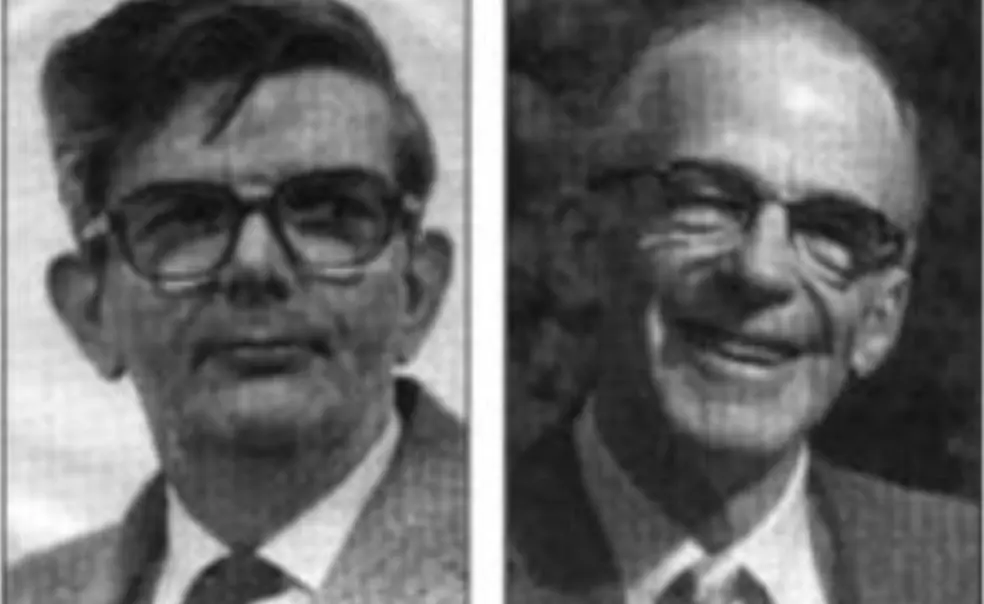In Memoriam: Lyman Spitzer Jr. *38 and Robert Dicke ’39
Two of the university’s most prominent scientists, Robert H. Dicke ’39 and Lyman Spitzer, Jr. *38, died in March. Dicke is widely known for his leadership in developing experimental tests of gravity physics and of the standard gravitational model for the large-scale evolution of the universe. Spitzer, a leading astrophysicist and the founder of the Princeton Plasma Physics Laboratory, conceived the large-scale observatory that became the Hubble Space Telescope.
Dicke, the Albert Einstein Professor of Science, emeritus, died March 4 at his home in Princeton of complications from Parkinson’s disease. He was 80. Dicke was responsible for a famous 1965 paper proposing that the then-mysterious background radiation permeating the universe is left over from the big bang. He invented the instrument used to detect this radiation, called the Dicke radiometer, now a standard astronomical tool. He is also credited with numerous patents related to the development of radar and laser technology and for his theoretical work challenging Einstein’s general theory of relativity. Dicke was unusual in making important contributions as both a theoretical and experimental physicist. “He is one of those very rare people who does both well,” his colleague, David T. Wilkinson, told PAW in 1980.
Born in St. Louis, Missouri, Dicke received his Ph.D. in 1941 from the University of Rochester. He joined the staff of MIT’s Radiation Laboratory in 1941 and came to Princeton in 1946. Dicke headed the physics department from 1967 to 1970. He retired in 1984.
In 1970, Dicke received the U.S. Medal of Science, the nation’s highest award for achievement in science. He was awarded honorary doctorates by the University of Edinburgh, the University of Rochester (which he attended for two years before transferring to Princeton), and Ohio Northern University.
Spitzer, the Charles A. Young Professor of Astronomy, emeritus, died of heart disease March 31 at his Princeton home. He was 82. His contributions included fundamental advances in four fields – the interstellar medium, stellar dynamics, plasma physics, and space astronomy. “Spitzer has chosen big problems to work on, and somehow, for him, complexities unravel and the fundamental simplicities become apparent,” Provost Jeremiah P. Ostriker wrote in the introduction to Dreams, Stars and Electrons: Selected Writings of Lyman Spitzer, Jr., recently published by Princeton University Press.
In 1951, he convinced the U.S. Atomic Energy Commission to try to harness the nuclear burning of hydrogen at temperatures found on the sun. First approved as Project Matterhorn, the Princeton Plasma Physics Laboratory at the James Forrestal Campus became a world leader in the quest to develop controlled nuclear fusion. After shepherding its creation, Spitzer led PPPL until 1967.
In theoretical physics, Spitzer is credited with the founding of the discipline of interstellar matter, which concerns the gas and dust between the stars from which new stars form. In a 1946 report, more than a decade before the launch of the first artificial satellite, he proposed the development of large space telescopes. Under his direction, a group of university scientists developed the 32-inch Copernicus ultraviolet satellite, launched in 1972, and later he steered the development of the Hubble Space Telescope.
Spitzer received his bachelor’s degree from Yale in 1935. He spent a year at St. John’s College, Cambridge University, before earning his Ph.D. at Princeton. He served on the Yale faculty from 1939 to 1942 before wartime service at Columbia University, then returned briefly to Yale before joining the Princeton faculty in 1947.
This was originally published in the May 7, 1997 issue of PAW.











No responses yet